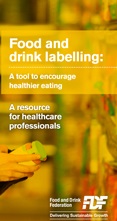At www.grub4life.com, an online community for nutrition in early years, we know some people find food labels confusing, however they needn’t be. We are delighted that FDF has produced this resource to help us healthcare professionals to be able to explain nutrition labelling to our patients.
Seeing the calories, fat, sugars and salt in a food at a glance can help
patients check and compare similar products and choose those with fewer
calories or
less fat. The more they compare products the more they become aware of what’s
in
the food they’re eating.
The label can also help clearly show patients the difference that portion size
can make. Think about asking someone to compare the different calorie and
nutrient levels between different sizes of snacks, like chocolate or crisps,
before
making their choice. Or ask patients to consider the impact of eating one, two
or
three sausages before they start cooking their evening meal! Just making
someone
stop and think before they buy or cook can really help impact on their dietary
choice.
Advising patients to use the labels can also help them decide when they are
happy to be indulgent. For instance, they might choose to save their favourite
full
fat mayonnaise to have with prawns, but use a low fat mayo in sandwiches or
coleslaw. Then again, they could also use labels to keep a tally of their fat
intake
over a day or a week – this might help them decide if they can afford to be
indulgent at all!
On top of this, labelling provides other essential information, such as any
allergens contained within a product, which is need-to-know information for all
of
those who suffer from allergies (as well as their families and friends). I hope
that you find this guide useful in your work as a healthcare professional and
it
helps you to help your patients understand food labels.

Nigel Denby, Registered Dietitian & Head of Nutrition www.grub4life.com
“Seeing the calories, fat, sugars and salt in a food at a glance can help
patients check and compare similar products and choose those with fewer
calories
or
less fat. The more they compare products the more they become aware of what’s
in
the food they’re eating.”
Nigel Denby,
Registered Dietitian & Head of Nutrition www.grub4life.com
